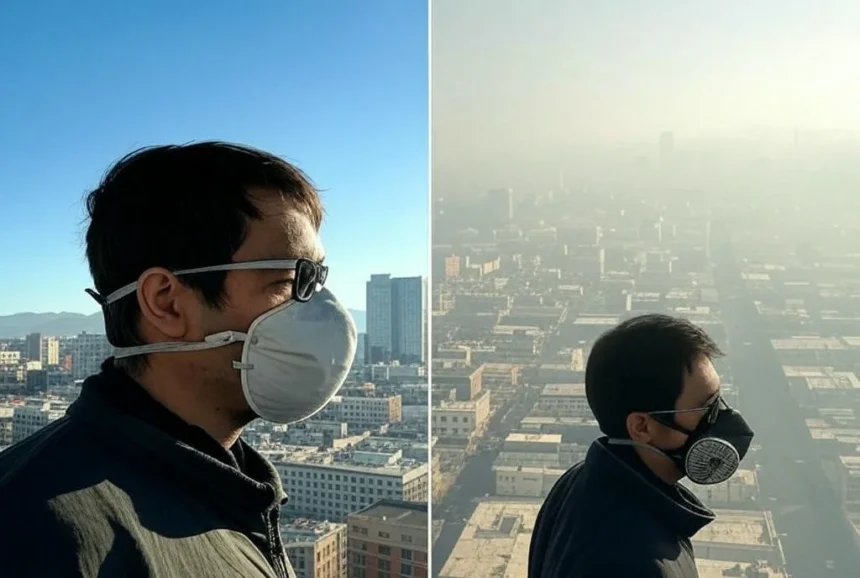Pollution is a growing concern worldwide, affecting the air we breathe, the water we drink, and the health of communities. In this blog post, we’ll explore a detailed comparison between Dorsten, a small city in Germany, and Fresno, a bustling city in California, USA. By looking at the “Dorsten vs Fresno pollution comparison,” we’ll uncover how these two cities handle air quality, what causes their pollution, and how it impacts residents. Whether you’re curious about environmental issues or planning to visit these places, this guide will give you clear, user-friendly insights into their pollution levels.
Why Compare Dorsten and Fresno Pollution?
Dorsten and Fresno may seem like an unlikely pair to compare. One is a quiet town in Germany’s North Rhine-Westphalia region, while the other is a busy agricultural hub in California’s Central Valley. However, both face unique pollution challenges shaped by their geography, industries, and policies. Understanding the “Dorsten vs Fresno pollution comparison” helps us see how different factors—like farming, traffic, and weather—play a role in air quality. This comparison also sheds light on how smaller towns and larger cities tackle environmental issues differently. Let’s break it down step by step.
The idea behind this comparison isn’t just to point out differences—it’s to learn from them. Dorsten’s cleaner air might offer lessons for Fresno, while Fresno’s efforts to fight pollution despite tough conditions show determination worth noting. By looking at these two places side by side, we get a clearer picture of how pollution works and what can be done about it.
Overview of Dorsten and Fresno
Before diving into the pollution details, let’s get to know these cities.
Dorsten: A Small German Town
Dorsten is a peaceful city with a population of about 75,000. Located near the Ruhr River, it has a history tied to coal mining and light industry. Today, it’s known for its green spaces and efforts to keep pollution low. Germany’s strict environmental laws help Dorsten maintain decent air quality. The city’s size and slower pace of life also mean fewer cars and factories, which keeps the air fresher compared to bigger urban areas.
Fresno: A Central Valley Powerhouse
Fresno, with a population of over 540,000, sits in California’s San Joaquin Valley. It’s a key player in America’s agriculture, producing crops like almonds, grapes, and citrus. However, its location in a valley traps pollutants, making air quality a big challenge despite efforts to improve it. Fresno’s larger population and busy economy bring more traffic and activity, adding to the pollution load. The mix of natural and human-made factors makes it a hotspot for air quality concerns.
Pollution Sources in Dorsten and Fresno
Pollution doesn’t come from just one place—it’s a mix of activities and natural factors. Here’s how Dorsten and Fresno differ.
Pollution Sources in Dorsten
- Industry: Small factories and past coal mining release some pollutants, like particulate matter (PM), into the air.
- Traffic: Cars and trucks add nitrogen dioxide (NO2) from exhaust fumes, though public transport keeps this lower than in bigger cities.
- Weather: Mild winds help spread pollutants, preventing them from building up too much.
In Dorsten, the pollution picture is fairly simple. The city’s industrial past left a mark, but modern rules have cleaned things up. Most days, you’ll find the air fresh enough to enjoy a walk without worry. The focus on buses and bikes also means fewer cars clogging the streets, which helps a lot.
Pollution Sources in Fresno
- Agriculture: Farming creates dust, pesticides, and ammonia, which harm air quality.
- Traffic: Heavy use of cars and trucks, especially along highways like Route 99, pumps out NO2 and carbon monoxide (CO).
- Wildfires: Summer wildfires send smoke and fine particles (PM2.5) into Fresno, worsening air quality.
- Geography: The valley traps pollutants, stopping them from blowing away.
Fresno’s pollution story is more complex. Farming keeps the economy strong, but it kicks up dust and chemicals that hang in the air. Add in the constant hum of traffic and the occasional wildfire smoke, and you’ve got a recipe for tough air quality days. The valley’s shape acts like a bowl, holding everything in, which is a big reason Fresno struggles more than Dorsten.
Air Quality Comparison: Dorsten vs Fresno
Air quality is measured using the Air Quality Index (AQI), which tracks pollutants like PM2.5, PM10, ozone (O3), and NO2. Let’s see how Dorsten and Fresno stack up.
Dorsten Air Quality
- AQI: Usually between 40-60 (moderate).
- PM2.5: Around 12-18 µg/m³—safe for most people.
- PM10: About 20-30 µg/m³—low enough to avoid major health risks.
- Ozone: Rarely a problem due to cooler weather and fewer reactions with sunlight.
- NO2: 10-20 µg/m³—kept low by strict vehicle rules.
Fresno Air Quality
- AQI: Often 100-150 (unhealthy for sensitive groups), sometimes worse during wildfires.
- PM2.5: 40-50 µg/m³—high and risky for health.
- PM10: 50-70 µg/m³—elevated due to dust and smoke.
- Ozone: High in summer (50-70 ppb) because of heat and traffic emissions.
- NO2: 40-50 µg/m³—driven by heavy traffic.
Here’s a quick table to compare:
| Factor | Dorsten | Fresno |
| AQI | 40-60 (Moderate) | 100-150 (Unhealthy) |
| PM2.5 (µg/m³) | 12-18 | 40-50 |
| PM10 (µg/m³) | 20-30 | 50-70 |
| Ozone (ppb) | Low | 50-70 (Summer) |
| NO2 (µg/m³) | 10-20 | 40-50 |
Health Impacts of Pollution
Pollution affects people’s health, especially kids, the elderly, and those with breathing problems. Let’s look at the risks in each city.
Health Risks in Dorsten
- Respiratory Issues: Mild cases of asthma or allergies from PM and NO2, but rare due to better air.
- Overall Impact: Low risk—Germany’s clean air policies protect residents well.
Dorsten residents can breathe easier—literally. The air quality stays good enough that health problems from pollution are uncommon. It’s a place where outdoor activities feel safe, and that’s a big plus for families and older folks.
Health Risks in Fresno
- Respiratory Problems: High PM2.5 and ozone levels lead to more asthma, bronchitis, and lung issues.
- Sensitive Groups: Kids and older adults face bigger risks, especially during wildfire season.
- Overall Impact: Higher rates of health problems tied to poor air quality.
In Fresno, the air can be a real worry. On bad days, you might notice more people coughing or staying inside. The combination of dust, smoke, and ozone hits hard, especially for anyone with asthma or other lung conditions.
Efforts to Reduce Pollution
Both cities are working to improve their environments. Here’s what they’re doing.
Dorsten’s Pollution Control
- Strict Laws: Germany follows EU rules to cut industrial and vehicle emissions.
- Public Transport: Buses and bikes reduce car use.
- Green Energy: More wind and solar power lower fossil fuel pollution.
Fresno’s Pollution Control
- Cleaner Vehicles: California pushes for electric cars and stricter emissions standards.
- Farming Changes: Programs encourage less pesticide use and better dust control.
- Air Monitoring: Local agencies track AQI and warn people on bad days.
Key Differences in Dorsten vs Fresno Pollution
- Geography: Dorsten’s flat land lets pollutants spread, while Fresno’s valley traps them.
- Main Sources: Dorsten deals with light industry; Fresno battles farming and wildfires.
- Regulations: Dorsten benefits from EU-wide rules, while Fresno fights bigger challenges despite state efforts.
- Air Quality: Dorsten’s air is cleaner year-round; Fresno’s gets worse in summer and fall.
Tips for Residents and Visitors
If you live in or plan to visit these cities, here’s how to stay safe:
In Dorsten
- Enjoy outdoor time—air quality is usually fine.
- Use public transport to keep pollution low.
In Fresno
- Check the AQI daily, especially in summer or during wildfires.
- Stay indoors on bad air days and use air purifiers.
- Wear a mask if you’re outside when pollution spikes.
Conclusion
The “Dorsten vs Fresno pollution comparison” shows two very different stories. Dorsten enjoys cleaner air thanks to strict laws, less traffic, and helpful weather. Fresno, on the other hand, struggles with trapped pollutants from farming, cars, and wildfires, despite efforts to improve. For residents and visitors, understanding these differences can help you make smart choices about health and travel. While Dorsten offers a model for managing pollution, Fresno’s challenges remind us how geography and industry can complicate solutions. Both cities show that fighting pollution takes teamwork—between governments, businesses, and people—to create a healthier future.
FAQs About Dorsten vs Fresno Pollution Comparison
What Causes Worse Pollution in Fresno Than Dorsten?
Fresno’s pollution comes from farming, heavy traffic, and wildfires, made worse by its valley location that traps air. Dorsten has lighter industry and better wind flow, keeping pollution lower.
Is Dorsten’s Air Always Safe to Breathe?
Most of the time, yes. Dorsten’s AQI stays moderate, meaning it’s safe for healthy people. On rare days with higher PM or NO2, sensitive groups might notice mild effects.
How Do Wildfires Affect Fresno’s Air Quality?
Wildfires in California send smoke and PM2.5 into Fresno, pushing the AQI into unhealthy levels. This happens mostly in summer and fall, making air quality much worse than Dorsten’s.
Can Fresno Improve Its Air Quality?
Yes, with steps like more electric vehicles, better farming practices, and wildfire management, Fresno can reduce pollution. However, its geography makes it harder than for Dorsten.
Which City Has Stricter Pollution Rules?
Dorsten benefits from Germany’s tough EU-wide environmental laws. Fresno follows California’s strict state rules, but its bigger pollution sources make enforcement tougher.





